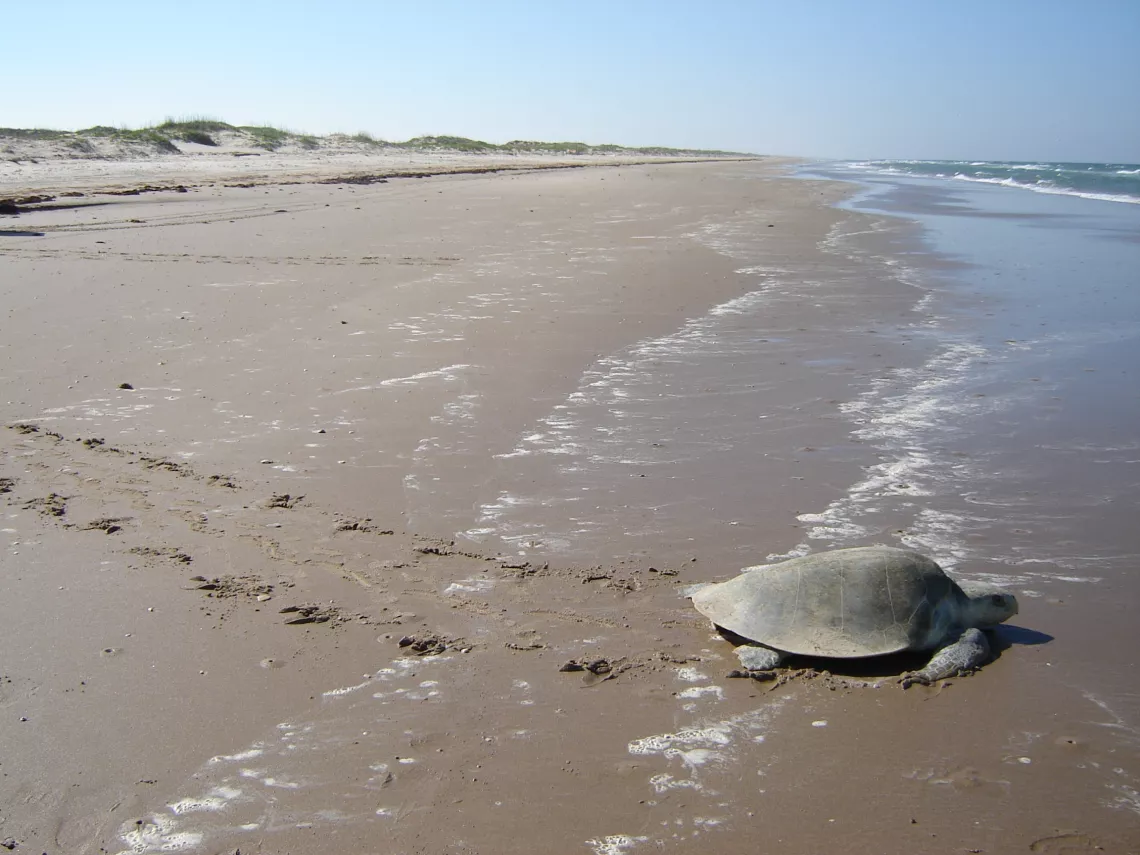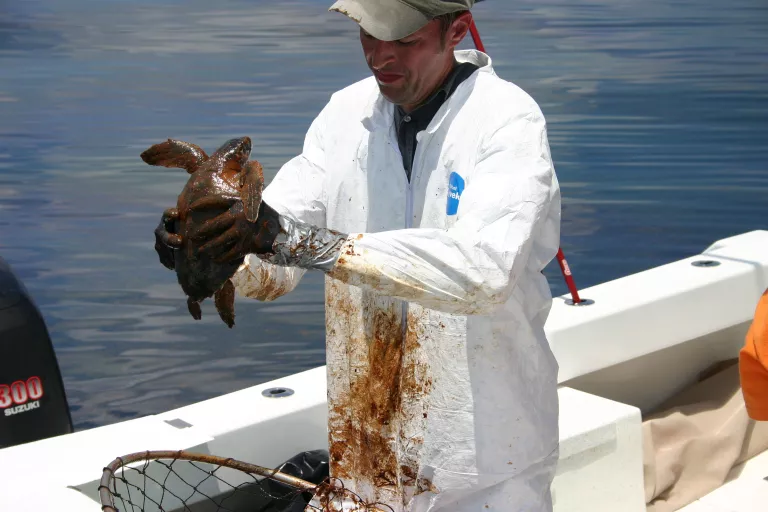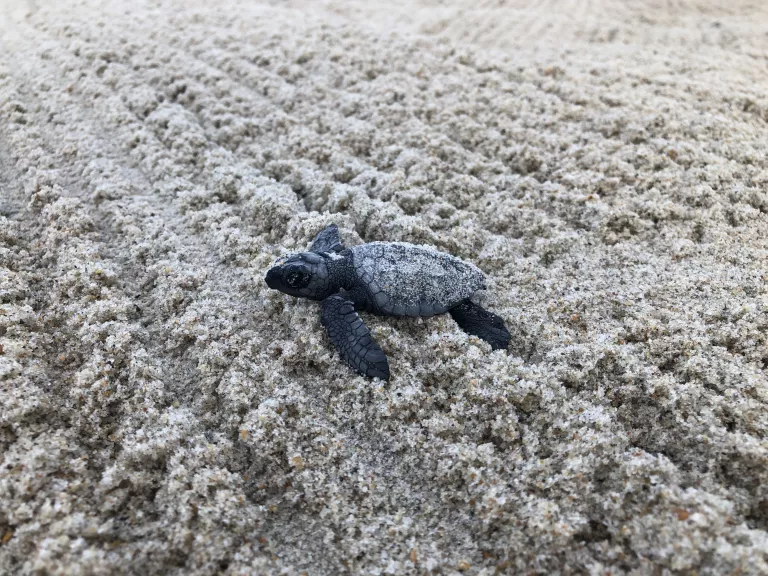
In the shimmering waters of the Gulf of Mexico resides the Kemp’s ridley sea turtle, the smallest and most critically endangered sea turtle species. Designated as endangered since 1970, Kemp’s ridley sea turtles have experienced significant population decline. Historically, the largest Kemp’s ridley nesting colony was on the beaches of Tamaulipas in Mexico. As part of joint recovery efforts between Mexico and the U.S., a significant nesting site was intentionally established in Texas to reduce the risk of losing the entire population of the Kemp’s ridley sea turtles if something happened to their primary nesting area in Mexico. Nowadays, these turtles are found throughout the Gulf coast, including the Texas coastline.
Current Threats and New Challenges to Kemp’s Ridley Sea Turtles
In Texas, Kemp's ridley sea turtles nest primarily around the Padre Island National Seashore. After recovery efforts began in the U.S., the Kemp’s ridley sea turtle population was noticeably increasing, reaching almost 20,000 nests located in Texas by 2009. However, following the Deepwater Horizon oil spill in 2010, turtle populations began to decline. In 2023, Texas scientists counted only about 150 nesting female turtles.

Seawater Desalination in Texas: A Growing Concern
According to the projections of the Texas Water Development Board (TWDB), Texas faces an 18% decrease in freshwater supplies by 2070, alongside a 9% increase in demand, underscoring the need for innovative water supply solutions. With the state’s population expected to exceed 51 million in the next 45 years, discussions around various water supply options among scientists, legislators, and environmentalists are intensifying. One such option is seawater desalination, a process that removes salt from seawater to make it suitable for everyday use. The byproduct of this process—concentrated brine—can be up to twice as salty as ocean water. This brine is often discharged back into the environment through various means of disposal, including—most concerning for Kemp’s ridley sea turtles—into Texas bays and estuaries.
While there are currently no operational seawater desalination facilities in Texas, five proposed projects are making progress in the Coastal Bend region, including two actively advancing through the regulatory processes of the Texas Commission on Environmental Quality (TCEQ) and the Environmental Protection Agency (EPA). The City of Corpus Christi is pushing forward with plans for the Inner Harbor desalination plant, which has faced substantial local and environmental opposition. As of this post, the project received both a water rights permit from TCEQ and an approval from EPA to process the permit application for discharging salty effluent into the Inner Harbor ship channel. Similarly, the Port of Corpus Christi has proposed another facility, also planning to discharge concentrated brine into the local bay system. Seven Seas Water, Corpus Christi Polymers, and Poseidon Water along with the City of Ingleside are among other entities currently seeking to add seawater desalination facilities along Corpus Christi Bay.
Environmental Impacts on Kemp’s Ridley Sea Turtles
While seawater desalination may seem like a practical solution for Texas’ growing freshwater needs, the process is fraught with environmental complications. The brine discharges could have detrimental effects on the delicate ecosystems of Texas’ bays and estuaries, which are home to numerous aquatic species. This situation poses a particular threat to Kemp’s ridley sea turtles, which thrive in shallow coastal waters rich in benthic invertebrate populations, like crab and shrimp, critical for foraging. While these turtle species can tolerate fluctuations in salinity levels to a certain degree, increased salinity can easily disrupt their food supply, which consists of salinity-sensitive species, such as blue crab. This disruption also extends to oysters, a keystone species essential for providing habitat to various marine species, including the blue crab. Oysters require less saline conditions to thrive, and their potential decline due to desalination waste can further destabilize the ecosystem.
Kemp’s ridley sea turtles also mate in low-salinity nearshore waters, and any increase in salinity could impact their mating behaviors and overall reproductive success. Additionally, the average incubation temperature of Kemp’s ridley sea turtle eggs determines the sex of hatchlings, with warmer conditions leading to a higher ratio of females. As climate change exacerbates this issue, the added heat from desalination processes could skew sex ratios even further, threatening the long-term viability of the population. Moreover, the combined effects of rising seawater temperatures and increased salinity can lead to the formation of oxygen-depleted areas, or “dead zones,” which further threaten various marine species and, by extension, the Kemp’s ridley turtles that depend on them.

Call for Salinity Standards to Protect Marine Life
As Texas considers seawater desalination as a viable water supply option, we must proceed with caution. As of today, the Texas Surface Water Quality Standards do not include any criteria for salinity in Texas’ bays and estuaries. Until either numeric or narrative salinity standards are established, TCEQ should not approve any new seawater desalination projects. Numeric salinity standards will provide clear and measurable criteria to protect our coastal ecosystems from the looming effects of the rapidly expanding desalination industry. While TCEQ acknowledges the need for such standards, the agency has not yet taken any concrete steps in that direction.
Citing the complexity of Texas’ unique estuarine systems since at least 1997 in TAC §307.4(g), TCEQ is avoiding their responsibility to protect our bays and estuaries:
“Numerical salinity criteria for Texas estuaries have not been established because of the high natural variability of salinity in estuarine systems, and because long-term studies by state agencies to assess estuarine salinities are still ongoing.”
However, after nearly three decades of research, the results of these studies have yet to be released and TCEQ has yet to establish salinity standards, while our bays and estuaries continue to be at risk.
An alternative approach to assessing salinity is to develop narrative criteria, following the path of our neighbor Louisiana. Like Texas, Louisiana’s bay system has significant natural variability in salinity. However, unlike Texas, Louisiana uses narrative salinity criteria for coastal water quality standards, focusing on salinity-sensitive species and their ecological contexts. For example, recognizing that certain aquatic species like blue crab or oysters thrive within specific salinity ranges can help inform better management of coastal environments and protect Kemp’s ridley sea turtles.
As we explore seawater desalination, we must ensure that we do not harm our coastal communities, wildlife, and the rich cultural heritage of our state. Protecting the Kemp’s ridley sea turtle and our coastal ecosystems is not just an environmental imperative; it is a commitment to saving our natural legacy for future generations. As we head into the 89th legislative session, the Lone Star Chapter plans to address the lack of salinity standards through proposed legislation. Specifically, we will advocate for establishing surface water quality standards for salinity that support aquatic life and protect the Texas coast from the impacts of desalination.
Join us for the TCEQ Surface Water Quality Assessment Advisory Work Group Meeting on Thursday, November 7th from 9am-12pm